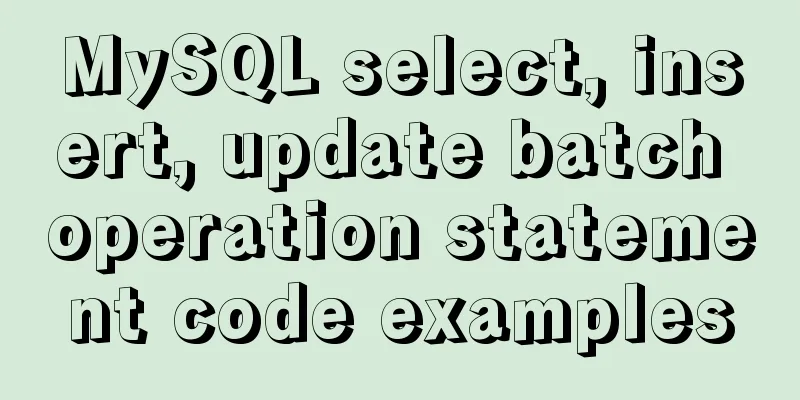Detailed explanation of JDBC database link and related method encapsulation

|
Detailed explanation of JDBC database link and related method encapsulation Using the MySQL database, first import the driver class, and then obtain the data link based on the database URL and username and password. Since the MySQL database is used, its URL is generally jdbc:mysql://host address:port number/library name. The following is the specific encapsulated class, which uses generics and reflection. However, there are still some problems. There are some restrictions on the generic objects used. They can only be used for objects whose attribute names of generic class objects are the same as the column names in the database table, and the method to initialize the object must be the set+attribute name method. I originally wanted to determine the property initialization method by the return value type and parameter list. However, maybe I have learned too little so far and have only studied for three weeks, so I have not implemented it. I feel that this method is still very low and needs to be improved in the future. I originally saw a useful beanUtils package on the Internet, which used map to save a queried column and directly convert it into the object, but I just wanted to try out the newly learned reflection. Moreover, the final garbage collector cannot be the same as the C++ destructor, so the place where the database connection is closed also needs to be improved. Implementation code:
public class Consql {
private static Consql consql=null;//Singleton design pattern private Connection conn=null;//Database link private final String url;//Database url
private final String username;//Database username private final String password;//Database password //Driver class loading static{//Load the driver class in the form of a static code block. The static code block is only executed once when the class is loaded try {
Class.forName("com.mysql.jdbc.Driver");
} catch (ClassNotFoundException e) {
e.printStackTrace();
}
}
//Constructor private Consql(String url,String username,String password) throws SQLException{
this.url = url;
this.username = username;
this.password = password;
open(); //Create a connection}
private Connection open() throws SQLException
{
try {//Driver obtains database link conn=DriverManager.getConnection(url, username, password);
} catch (SQLException e) {
// TODO Auto-generated catch block
//e.printStackTrace();
throw e;
}
return conn;
}
/**
* Search with restriction conditions * @param sql with placeholders? sql statement * @param t returns the class of the related type object (T.class)
* @param params replaces the placeholder data, which is a dynamic array * @return ArrayList<T>
* @throws SQLException
*/
public <T> ArrayList<T> select(String sql,Class<T> t,Object...params) throws SQLException
{//Get all public methods of class T Method[] declaredMethods = t.getDeclaredMethods();
//Create an ArrayList<T> collection to hold objects of this type arrayList=new ArrayList<>();
try (PreparedStatement pStatement=conn.prepareStatement(sql);)
{
for(int i=0;i<params.length;i++)
{
pStatement.setObject(i+1, params[i]);
}
try(ResultSet rSet=pStatement.executeQuery();)
{
ResultSetMetaData rData=rSet.getMetaData();
//Get the number of columns in the query result table int columnCount = rData.getColumnCount();
while (rSet.next()) {
T a=t.newInstance(); //Create a generic class instance for(int i=0;i<columnCount;i++)
{//Get the set method in the square array. This causes limitations. Only the database table column name can be consistent with the object name, and only the set method String aString="set"+rData.getColumnName(i+1);
for (Method method : declaredMethods) {
if(method.getParameterCount()==1&&method.getReturnType().toString().equals("void")&&method.getName().equalsIgnoreCase(aString))
{//There is a problem here. The first two judgment conditions are basically useless. The main reason is that I didn’t want to use the string method above to determine whether to call the method of the parameter method.setAccessible(true);
//Call this method using reflection method.invoke(a, rSet.getObject(i+1));
break;
}
}
}
arrayList.add(a);
}
} catch (InstantiationException e) {
// TODO Auto-generated catch block
e.printStackTrace();
} catch (IllegalAccessException e) {
// TODO Auto-generated catch block
e.printStackTrace();
} catch (IllegalArgumentException e) {
// TODO Auto-generated catch block
e.printStackTrace();
} catch (InvocationTargetException e) {
// TODO Auto-generated catch block
e.printStackTrace();
}
} catch (SQLException e) {
// TODO Auto-generated catch block
throw e;
}
return arrayList;
}
/**
*Data insertion* @param sql with placeholder? SQL statement * @param params replaces the placeholder data, dynamic array * @throws SQLException
*/
public void insert(String sql,Object...params) throws SQLException
{
try(PreparedStatement pStatement=conn.prepareStatement(sql);) {
for(int i=0;i<params.length;i++)
{
pStatement.setObject(i+1, params[i]);
}
pStatement.executeUpdate();
} catch (SQLException e) {
// TODO Auto-generated catch block
throw e;
}
}
/**
*Data update* @param sql with placeholder? SQL statement * @param params replaces the placeholder data, dynamic array * @throws SQLException
*/
public void update(String sql,Object...params) throws SQLException
{
try(PreparedStatement pStatement=conn.prepareStatement(sql);) {
for(int i=0;i<params.length;i++)
{
pStatement.setObject(i+1, params[i]);
}
pStatement.executeUpdate();
} catch (SQLException e) {
// TODO Auto-generated catch block
throw e;
}
}
/**
* Delete with restriction conditions * @param sql with placeholder? SQL statement * @param params replaces the placeholder data, dynamic array * @throws SQLException
*/
public void delete(String sql,Object...params) throws SQLException
{
try(PreparedStatement pStatement=conn.prepareStatement(sql);) {
for(int i=0;i<params.length;i++)
{
pStatement.setObject(i+1, params[i]);
}
pStatement.executeUpdate();
} catch (SQLException e) {
// TODO Auto-generated catch block
throw e;
}
}
/**
* Delete all, without restriction * @param sql
* @throws SQLException
*/
public void deleteall(String sql) throws SQLException
{
try(PreparedStatement pStatement=conn.prepareStatement(sql);) {
pStatement.executeUpdate();
} catch (SQLException e) {
// TODO Auto-generated catch block
throw e;
}
}
/**
* Unrestricted search * @param sql
* @param t generic class T.class
* @return ArrayList<T>
* @throws SQLException
*/
public <T> ArrayList<T> select(String sql,Class<T> t) throws SQLException
{
Method[] declaredMethods = t.getDeclaredMethods();
ArrayList<T> arrayList=new ArrayList<>();
try (PreparedStatement pStatement=conn.prepareStatement(sql);)
{
try(ResultSet rSet=pStatement.executeQuery();)
{
ResultSetMetaData rData=rSet.getMetaData();
int columnCount = rData.getColumnCount();
while (rSet.next()) {
T a=t.newInstance();
for(int i=0;i<columnCount;i++)
{
String aString="set"+rData.getColumnName(i+1);
for (Method method : declaredMethods) {
if (method.getName().equalsIgnoreCase(aString))
{
method.setAccessible(true);
method.invoke(a, rSet.getObject(i+1));
break;
}
}
}
arrayList.add(a);
}
} catch (InstantiationException e) {
// TODO Auto-generated catch block
e.printStackTrace();
} catch (IllegalAccessException e) {
// TODO Auto-generated catch block
e.printStackTrace();
} catch (IllegalArgumentException e) {
// TODO Auto-generated catch block
e.printStackTrace();
} catch (InvocationTargetException e) {
// TODO Auto-generated catch block
e.printStackTrace();
}
} catch (SQLException e) {
// TODO Auto-generated catch block
throw e;
}
return arrayList;
}
/**
* Return the number of rows in the table * @param tableName database table name * @return number of rows * @throws SQLException
*/
public int count(String tableName) throws SQLException
{
String sql="select count(*) from "+tableName;
try(PreparedStatement pStatement=conn.prepareStatement(sql);
ResultSet rsSet = pStatement.executeQuery(); )
{
if(rsSet.next())
{
return rsSet.getInt(1);
}
} catch (SQLException e) {
// TODO Auto-generated catch block
throw e;
}
return 0;
}
/**
* Determine whether the data exists * @param sql contains placeholders? SQL statement * @param params replaces the placeholder data, dynamic array * @return boolean
* @throws SQLException
*/
public boolean isExist(String sql,Object...params) throws SQLException
{
try(PreparedStatement pStatement=conn.prepareStatement(sql);)
{
for(int i=0;i<params.length;i++)
{
pStatement.setObject(i+1, params[i]);
}
try(ResultSet rsSet=pStatement.executeQuery();) {
if(rsSet.next())
{
return true;
}
finally
}
} catch (SQLException e) {
// TODO Auto-generated catch block
throw e;
}
return false;
}
/**
* Create an instance * @param url database url
* @param username username * @param password password * @return consql object * @throws SQLException
*/
public static Consql getnewInstance(String url,String username,String password) throws SQLException
{
if(consql==null)
consql = new Consql (url, username, password);
return consql;
}
//Garbage collection, it seems that it cannot achieve the effect of the destructor protected void finalize() throws Throwable
{
if(conn!=null)
{
conn.close();
}
super.finalize();
}
}The above is a detailed example of the encapsulation of JDBC database links and related methods. If you have any questions, please leave a message or discuss in the community of this site. Thank you for reading and hope to help everyone. Thank you for your support of this site! You may also be interested in:
|
<<: Docker Data Storage Volumes Detailed Explanation
>>: Detailed explanation of Bind mounts for Docker data storage
Recommend
2017 latest version of windows installation mysql tutorial
1. First, download the latest version of MySQL fr...
Detailed explanation of MySQL 8.0 password expiration policy
Starting from MySQL 8.0.16, you can set a passwor...
Detailed explanation of root directory settings in nginx.conf
There are always some problems when configuring n...
My CSS architecture concept - it varies from person to person, there is no best, only suitable
Preface <br />I have been working in the fro...
Implementation of remote Linux development using vscode
Say goodbye to the past Before vscode had remote ...
Detailed explanation of HTML's <input> tag and how to disable it
Definition and Usage The <input> tag is use...
How to quickly import data into MySQL
Preface: In daily study and work, we often encoun...
TypeScript union types, intersection types and type guards
Table of contents 1. Union Type 2. Crossover Type...
Navicat for MySQL 11 Registration Code\Activation Code Summary
Recommended reading: Navicat12.1 series cracking ...
Implementing a simple timer in JavaScript
This article example shares the specific code of ...
Detailed explanation of the 8 attribute values of the background attribute (interview question)
The value of the background property in CSS backg...
How to deploy LNMP architecture in docker
Environmental requirements: IP hostname 192.168.1...
Detailed explanation of nginx proxy_cache cache configuration
Preface: Due to my work, I am involved in the fie...
Detailed analysis of replication in Mysql
1.MySQL replication concept It means transferring...
JavaScript offsetParent case study
1. Definition of offsetParent: offsetParent is th...









